By Mark Ellis —
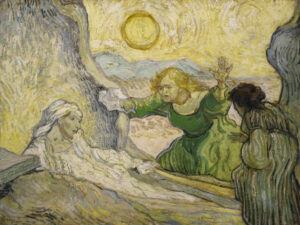
A record 1.2 million visitors came to the giant retrospective of Van Gogh’s work in Amsterdam in 1990, which coincided with the 100th anniversary of the Dutch post-Impressionist’s death. What visitors did not see at that major exhibition were van Gogh’s Christian-themed paintings, which were left in the basement of the museum.
“None of the religious imagery was in the show. It was deliberately kept in the basement,” says William Havlicek, Ph. D , author of “Van Gogh’s Untold Journey” (Creative Storytellers). “In Western art there has been a move toward secularization through existential thinking,” he notes, which followed the disillusionment of many artists after two world wars.
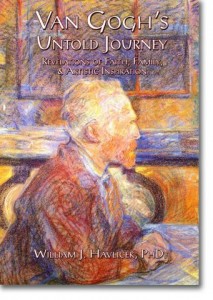
Havlicek spent 15 years researching and studying more than 900 of van Gogh’s letters. His revealing book dispels many of the myths that surround the painter’s tumultuous life. “Vincent’s letters portray a very different story than the popular tale of the mad artist who cuts off his ear,” Havlicek notes. “What emerges instead is a story of selfless loyalty, the epitome of the Gospel’s sacred counsel – ‘love one another.’”
“Many of his religious letters were held back and only released in the last five or six years,” Havlicek adds.
Vincent’s father and grandfather were pastors and it seems many in the van Gogh family gravitated toward religion or art. His father Theodorus – a Dutch Reformed minister — was not known as a compelling preacher, but a “welfare pastor” who distributed food and clothing to the poor, Havlicek notes.
As Vincent’s zeal for Christ grew in his early twenties, he wanted to study theology, but failed his entrance exam for seminary. Instead, he went off to serve as a missionary to coal miners in the Borinage district of Belgium.
He found miners who were sick and starving, living a bleak existence, without adequate food, water or warm clothing. A mining explosion had left many in a horrible condition. Fighting for survival, they apparently had little interest in his evangelistic appeals.
In response to their plight, Vincent gave away everything he owned, including most of his clothing. To tend to their medical needs, he
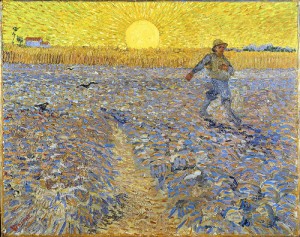
ripped up his own bed sheets for bandages, and slept on straw on the ground. “By such actions he won the admiration and respect of the workers, and was able to convert some of them,” Havlicek notes.
“Vincent was a very generous man. He understood that unconditional love of God extended to unconditional love for others. He would never recognize love that was not an action.” Van Gogh was also inspired by the writings of Charles Dickens in his compassionate response to human suffering.
Sadly, a church committee overseeing Vincent thought he suffered from excessive zeal and fired him because he did not dress or preach eloquently. “It did not seem to matter to them that he literally poured out his life in sacrifice and service on behalf of the diseased and destitute,” Havlicek laments.
Vincent went home to his parents, but the physical and emotional ordeal of caring for the miners and the rejection by the church hierarchy had taken its toll. He appeared to suffer a nervous breakdown, which caused his father to make his first quiet inquiries about committing Vincent to an asylum.
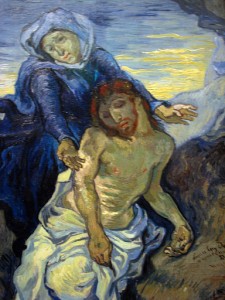
At the same time, the drawings Vincent had made of miners and others captured his brother Theo’s interest. He persuaded Vincent to begin formal art studies at the Académie Royale des Beaux-Arts in Brussels. Van Gogh wanted to continue to serve God with his art, stating: “…to try to understand the real significance of what the great artists, the serious masters, tell us in their masterpieces, that leads to God. One man wrote or told it in a book, another in a picture.”
In 1881, he fell in love and proposed marriage to woman who was seven years older. She turned him down, but his advances persisted in a clumsy manner. Exasperated, the woman and her parents forcibly rejected Vincent, partly due to the struggling artist’s inability to support himself.
During the time Vincent lived with his family, Vincent and his father got into more and more heated arguments. After one particular violent exchange on Christmas day when Vincent refused to go to church, Vincent left to live on his own in The Hague.
The following year Vincent attempted to rescue a prostitute, Sien Hoornik. He wrote of his unusual relationship with Hoornik in his letters: “I met a pregnant woman, deserted by the man whose child she carried. A pregnant woman who had to walk the streets in winter, had to earn her bread, you understand how, I took this woman for a model and have worked with her all winter. I could not pay her the full wages of a model, but that did not prevent my paying her rent, and, thank God, so far I have been able to protect her and her child from hunger and cold by sharing my own bread with her.”
As one might imagine, his family was shocked he had taken in a prostitute and pressured him to alter his living arrangement. His
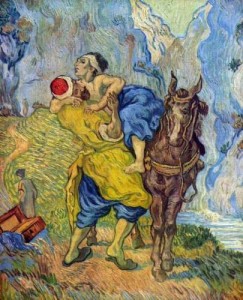
parents continued to explore the idea of committing Vincent to an asylum due to his errant behavior.
Vincent’s father died of a stroke in 1885 and Vincent’s sisters blamed him for “murdering” his father, due to the emotional fallout from their intense discussions and unresolved conflict.
After his father’s death, Vincent went into a tailspin. “Vincent embarked on a three-year drinking binge in Paris,” Havlicek notes. “This was the most destructive period of his life. Even so, he continued to produce some remarkable work inspired by the Impressionists who exhibited in the great city.”
He experimented with absinthe, which was a highly popular drink in some circles made from unstable wormwood alcohol. The unpredictable side effects for many users included nerve damage, blindness, and insanity. Absinthe may have triggered the epileptic seizures that began to plague Vincent during this period.
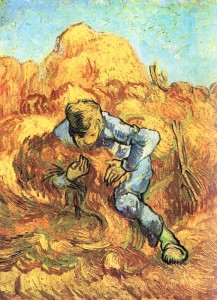
“After drinking a large quantity of absinthe, Vincent slashed off a portion of his ear,” Havlicek recounts. “It’s possible he had a grand mal seizure when he slashed the upper part of his ear,” he says.
Most art critics and historians believe Vincent lost his faith sometime between 1882 and 1885. Yet Havlicek found abundant evidence in Vincent’s letters and his art that an abiding faith remained, even as his health and behavior deteriorated. Surprisingly, most of the Christian-themed paintings appeared in the last three years of his life.
For the sake of self-preservation, Vincent moved to Arles in southern France, where he had an unusual meeting one day in a café he frequented. A local peasant walked in who bore a striking resemblance to his deceased father. “This chance meeting led to some of the most emotionally wrought portraits in the history of art – a father’s posthumous portrait painted vicariously using the face of another,” Havlicek notes.
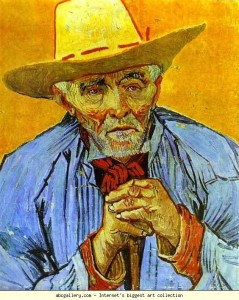
Vincent painted the man’s hands clasped as if in prayer, holding a shepherd’s staff. “He surrounded his father in a gold light, which is always a symbol of the divine,” Havlicek notes. “It’s a sacred work; Vincent loved sacred references.”
Havlicek made the significant discovery that a saintly bishop’s ruminations on the cosmos in Victor Hugo’s Les Miserables inspired one of Vincent’s most famous works, The Starry Night:
Victor Hugo wrote, “He was there alone with himself, collected, tranquil, adoring, comparing the serenity of his own heart with the serenity of the skies, moved in the darkness by the visible splendours of the constellations, and the invisible splendour of God, opening his soul to the thoughts that fall from the Unknown. In such moments offering up his heart at the hour when the flowers of night inhale their perfume, lighted like a lamp in the centre of The Starry Night…”
Vincent used the same title for his painting and Havlicek notes the striking similarities. “The theme of Les Miserables is redemption,” Havlicek observes. In van Gogh’s painting, “the stars are painted like flowers. There is an interaction between the earth and heaven. It is as if heaven is reaching down.”
“Starlight implies in Vincent’s view that the darkness of sin, guilt, and death are overcome by divinely mediated grace.”
“Van Gogh’s interest in the Gospel is very profound,” Havlicek says. His paintings, The Good Samaritan, The Raising of Lazarus, The
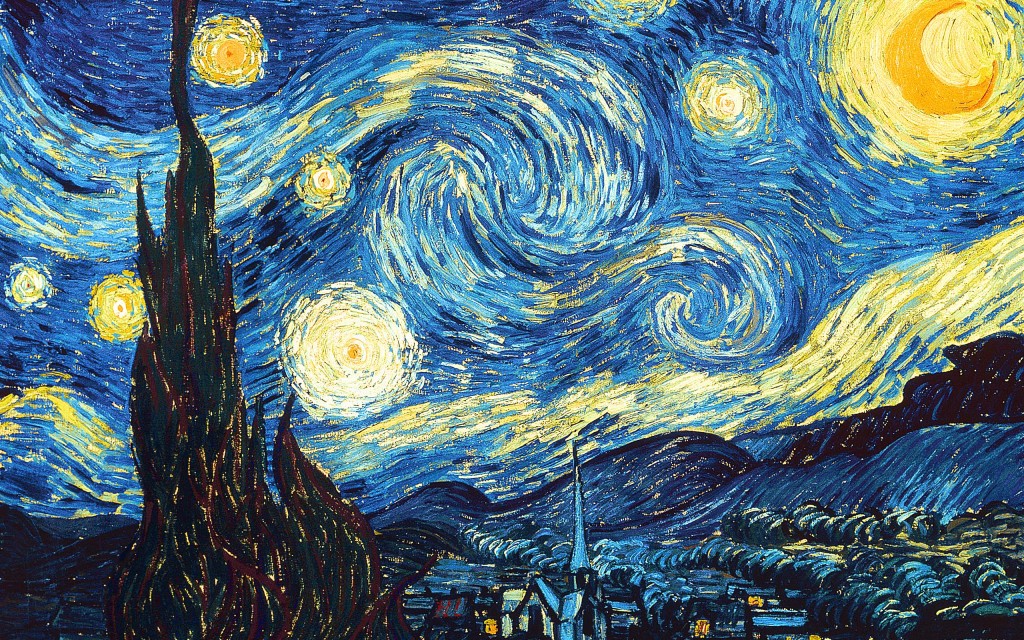
Sower, The Sheaf Binder (or harvester) all display Christ-centered themes.
Havlicek even sees the work of Christ in van Gogh’s famous painting of sunflowers. “In 1886 van Gogh found sunflowers thrown in a street gutter in Paris. He went home and painted these beautiful cast-off flowers. The way the flowers were transformed through love shows redemption.”
Van Gogh died under unusual circumstances in what most label a suicide, but Havlicek has some doubts. “No gun was ever found,” he says, and there were no powder burns near the fatal wound to his abdomen.
Two boys admitted they were target shooting near van Gogh and had an encounter with him that appears suspicious. “One wrote a confessional letter years later saying they were harassing van Gogh. He didn’t admit he shot him, but he said there were things he did to him he wish he’d never done.”
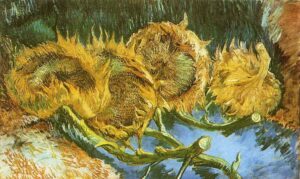
Vincent lingered for two days after the fatal shot. When he was interviewed by police, Vincent said, “I’m hurt but don’t blame anybody else.”
Havlicek believes that if he was shot accidentally by the boys, it was consistent with Vincent’s character to withhold that information. “He had a very sacrificial aspect to his personality. There were several times in his life when he took the blame for someone else,” he says.
“He loved Christ enormously at the end of his life,” Havlicek maintains. “He said Christ alone among all the magi and wise men offered men eternal life. In spite of a broken life, something glorious emerged.”
Dr. William Havlicek has over 30 years of experience in college teaching, museum administration, publishing and fine art/studio production and exhibition. He holds a Ph. D from Claremont Graduate University. He currently teaches at the Laguna College of Art and Design in Laguna Beach, California. Proceeds from the sale of his book are donated to PROGENY, an international organization dedicated to the rescue, treatment, and rehabilitation of exploited and endangered children and the pursuit of justice on their behalf.




hello–I was so happy to see this article–and see the paintings. Am so thrilled beyond measure that Vincent loved the Lord all his life, really. I heard he had bi-polar illness; is this true? Appreciate him more now as a person and as an artist. Seemed to have been killed perhaps by the 2 boys as Vincent, as you say to the effect that he had a very tender and sacrificial heart and spirit. He never got married it seems? Do you know why he never got married? At what age did he die?? Did he ever make up with his mother and siblings? Thank you and I hope to hear from you soon, Suzanne
Thank you for the kind questions: No he never got married. He was 37 when he died. Yes he did make up with his family in last months of his life. Please consider getting our book it answers all of your questions and much more : )
I am Aaron from Singapore and would like to buy “Van Gogh’s Untold Journey” by Dr William Havlicek. Please let me. know how much it costs? Thank you
WOW! My husband and I are so glad to get this information about Van Gogh. It is so sad that his Christian selfless life was hidden for so long. We are so grateful for those who are bringing it to light. We have always admired his paintings, but now admire his life as well. What spiritual warfare he endured. God’s grace is so great.
Dear Millie,
Thank you for your wise comments on the importance of grace in our human journey through this distorted world. Van Gogh surely suffered much as a result of his misunderstanding of God’s grace. Vincent was tormented by a form of legalism that meant he tried to win God’s approval. When he failed to convince himself that he had succeeded (of course no one can do this) he felt rejected.
When at the end of his life he could do nothing to save himself he likely experienced God’s unmerited Grace for the very first time. We can all relate to this need to give up our notion of self-righteousness and claim the Gift of unmerited Grace. Vincent’s story is our story– only it is amplified and intensified. We are all saved by Grace and not of ourselves.
thank you – wonderful
I knew about Van Gogh’s Christian influences, but this article puts everything in an even more redemptive light for me. The new paintings provide the evidence. Just goes to show you that anything so beautiful as Van Gogh’s paintings ultimately must originate from a sacred place. Too bad the modern art establishment has seen fit to hide the influence of Christianity on Van Gogh’s life and work. This establishment seems full of evil, deceitful people.
Dear Tom,
I can understand your strong feelings about the establishment and the repression of religious expression. In the case of the Van Gogh Museum not showing the sacred works there is one other consideration, namely the tradition of the Dutch for moderation ie. Laissez-faire.
Yet the desire for moderation cuts both ways so that too much compliance produces no clear view and too little flexibility becomes a form of legalism. With Van Gogh however when his artistic creed and testimony is repressed, effectively the truth of art history is distorted. So in the end, Laissez-faire in art exhibitions must yield give way and reveal the entire range of an artist’s lifework— which for Van Gogh has to include his great-late religious works.
Mr. Ellis thank you for this article, for bringing Havlicek’s book and van Gogh’s work and life to light. Such sacrifices as van Gogh’s cannot be hidden any more than darkness can quench the light. I look forward to hearing the rest of the story one day from van Gogh himself. What an incredible story that will be. Meanwhile, I’ll buy Havlicek’s book and hope to one day sit and gaze at van Gogh’s famous painting and breathe the fragrance of the grace that one master used to portray our redemption by another Master.
Dear Jeff,
Thank you for the kind note and I love your use of light out of darkness in your word choices. That image was one of Van Gogh’s most favorite and of course we find it in the Gospel of John and the Book of Genesis. Christ as the light of the world.
I hope you enjoy our book and do feel free to email me when you have completed it and I would love to hear your thoughts. Blessings !
I thank you Mr. Ellis for this inspirational writing and for Dr. Havlicek’s revealing work, regarding Van Gogh. I do not know much about this great painter, except what mostly a christian friend who’s also an artist and painter, told me once about him. Which was mostly, about his emotional disturbances, his drinking during the years mentioned, about him ripping his ear and that he was a great painter that was one of his favorites. But this information lights up a whole different perspective about Van Gogh’s life. We are quick to judge people and their life situations through what we see, what we hear and what we know. But we don’t always know the whole truthful story. Ultimately, it is only GOD through his son Jesus Christ, who is the ultimate judge. But as Jesus would say to those who go to him in a humble and a repentant attitude: “Where are the ones who condemn you?”.
Dear John,
Yes what you say about judging another life is so true–God is the only One who can. The story of Van Gogh gives one pause because he has been unfairly portrayed as a degenerate person, madman and fool by many. His art and life story is that of a human being saved by grace in my view. He is as worthy of grace as any of us and he suffered far more than most of us. I can only say now– having spent so much of my time and energy studying this man that he is something like Samson—powerfully gifted, often misdirected but a child of God all the same.
Thank you so much for this article. It has answered questions I’ve had in mind for many years about one of my favourite artists.
Mark, You are most welcome. Completing the research on his life and art was one of the most important experiences in my life. Discovering convincing evidence of a return to faith in Van Gogh’s spiritual journey was both a revelation of sorts and I was humbled to be given an opportunity to share this with any who seemed to care. Caring about others is surely a demonstration of the Gospel mandate- “To Love one another” remarkably Van Gogh kept repeating that commandment to his last breath.
And if that is not one sign of salvation then Van Gogh’s famous quote “I would never recognize love that was not an action” —that comment should convince one even more– because it is really a paraphrase The Book of Romans and Paul’s great insight into the meaning of redeeming action through of the life and sacrificial death of our Lord and Savior.
What a wonderful true story. I learnt to love the work of Van Gogh through a teacher when I was 11 and always sought out his work in many galleries. It was a thrill to be in New York 2 or 3 years ago when MOMA had an exhibition of his work featuring The Starry Sky. I enjoyed reading the comments and replies also. I hope I can get the book, I live in Australia.
Dear Beverly,
We do ship Bill Havlicek’s book on Van Gogh to Australia. The published price includes all taxes and shipping. The link is http://www.creativestorytellers.com/vangogh
David Glen
Publisher
My daughter, Melissa an art graduate from Western Washington University living and working in LA is experiencing a battle with personal faith in Christ. I think she would love your book and maybe a visit to your campus. She is thinking about graduate school.
How do I purchase “Van Gogh’s Untold Journey” ? I would love a signed copy if possible for Christmas.
I have an interest, as you mentioned in an e-mail a comparison of Van Gogh and the Bible character Samson as stated, “He is as worthy of grace as any of us and he suffered far more than most of us. I can only say now– having spent so much of my time and energy studying this man that he is something like Samson—powerfully gifted, often misdirected but a child of God all the same.”
Have you studied Samson’s life?
God bless you.
Andy
http://www.creativestorytellers.com/vangogh/
Andy,
Thank you for your interest in our book and my sincere support in the instance of your daughter and her struggle with faith. The Van Gogh story is also such a struggle but you will see that the story ends well.
To order our book simply use the line above at the top of my reply here. The book will be author signed and I am glad to take email questions should there be followup after the book is read. Blessings, William Havlicek PhD.
Thank you for opening my eyes to the true story of Vincent. I could not help but feel that his father was harsh and over-bearing toward Vincent, despite his charitable works. Also, both his parents seemed to be too eager to put him in an asylum. One wonders as to whether that might not be more because of the shame they felt he brought upon their name, (from taking in a prostitute,) than any real concern for Vincent. (Then they could “explain” it away by telling neighbours, he had gone insane.) The sisters in their grief at their fathers’ death, were cruel to him also. Glad he overcame in the end.
This is a most interesting story. I, as well, only heard of the negative aspects of Van Gogh’s life, and not being a big art enthusiast, never looked further into his life. Though it seems that until now there was no honest portrayal of the life that he lived (under the radar). Kudos to Dr. Havlicek for unvieling this most redeeming account of a great artist. The Lord is smiling on your work!
Claudia,
Many thanks for your kind comments and I do appreciate your concern that the story of Van Gogh and his quest for faith be properly told. Should you want an author-signed copy of our book simply use the link here: http://www.creativestorytellers.com/vangogh/
This was a most fascinating article.
How can I order the book?
I would appreciate your help/What is the process?
http://www.creativestorytellers.com/vangogh/
Ursula,
Thank you for your interest in our book. It is easy to order one simply use the link above and Paypal will accept your payment. You will receive an author-signed copy in only a few days. Our book makes a great Christmas gift as it is not only beautifully printed with high quality color reproductions but each purchase will go to a charity for children.
Blessings, Bill Havlicek PhD.
I was overjoyed to receive the two copies of your book so quickly. This is a true gift from God, because it touches me in so many ways. I am totally amazed that you devoted so much of your life to this research and uncovered this amazing artist’s genius, coupled with his spirituality – what a combination!
Growing up in Germany, and appreciating art, I had an opportunity to see an exhibit of some of Van Gogh’s works and I have never been the same, since. One time I had the opportunity to go to Marseiles/France and actually see the colorful fishing boats in the harbor, just like the painting.
On the same trip I also had the opportunity to visit Arles and I was in awe, knowing he lived and worked there, also. Your book is a treasure and one copy goes to my granddaughter for Christmas – she is a gifted artist herself and I hope the book will be a companion on her life’s journey and a blessing.
Thank you, again, for your work of love, which is a blessing in numerous
ways.
Dear Ursula,
My sincere thanks for your kind note and the wonderful personal story that you shared with your own encounter with Vincent. That you were able to visit such important places in Van Gogh’s artistic life is remarkable and it brings you one step closer to understanding the rich legacy of his art and life.
My long journey as an artist and scholar tracing Van Gogh’s life has been a blessing to me and one that seems to ever open to more opportunities to share his legacy. God was involved with this man in many ways much as God was with Saul who became Paul zealous men who were broken and weak so that the glory of God could be better seen. “Sorrowful but always rejoicing” – as Vincent loved to say all his life, quote St. Paul knowingly.
Many blessings dear Ursula and thanks again as your purchases help abandoned children because net profits go to charity set up by my publisher.
Unfortunately while taking in the prostitute … he failed to keep his pants buttoned…
Van Gogh was a sinner and like all of us, he made bad choices and suffered the effects of them, in this case it was venereal disease. What makes his story valuable is that he did not gloss over his mistakes but left a record of them for others to learn from. He also left us a record of his achievements and gifts to humanity in the form of radiant art works with a sacred meaning such as “The Starry Night.” I have often thought of Samson in following the life of Van Gogh for the Old Testament hero was terribly flawed and so was Vincent.
As I suspected, Vincent is my brother, and I’m hopeful you are as well. I was deeply immersed in the waters of religion, until the Lord had mercy on me a little over two years ago. I have left the “church” and seminary to be united to Christ. I have found His Body and look very forward to the wedding day of all the saints in Christ Jesus. I completely understand why Vincent refused to go to “church” on Christmas….one of Satan’s finest deceptions. I also understand his love for Victor Hugo’s, Les Miserables. I’m sure he would have also seen Christ in “The Shawshank Redemption.” This article brought me to tears….the beauty of Christ in my brother, Vincent. Thank you.
You have succeeded, by your years’ profound investment resulting in this work, furthering Van Gogh’s ‘answer to every man’. You verify the widespread conviction that his faith led his artist life and far outshine his failings. My heart thrills at your publication’s sensitivity to utterly complete Van Gogh’s self portrait, and especially so, given the museum’s inexcusable censorship.
Since the early 90s, through time spent in reflecting on Vincent’s letters, savoring his works of art, and investigating his life and journey I too had concluded much of what I just read in the brief synopsis from you book by Ellis. I look forward to getting a copy of your book. Later on in the 90s, I came across the book “At Eternity’s Gates” (Erickson), which was a refreshing confirmation for me. I also, had concluded that it was certainly possible that the two young boys had carried out the deed, but Vincent’s vicarious nature, would not allow them to take the blame. I was drawn to the study of his life due to my own stumblings as a young evangelical believer. At the age of 17, I attempted to take my own life with my grandfather’s gun, and in the end, if Vincent did in fact take his own life, this did not undermine my conclusion that he was a man of genuine faith. In fact it might have even been Gauguin in one of his argumentative outbursts with Vincent, who using one of his collected sabers, sliced Vincent’s ear off in a fit of rage. Yet it seems obvious that Vincent did send his mutilated ear to a brothel near his home, to be sure consistent with something Vincent would do. Vincent, as is true of all of God’s own was not a perfect human being, yet graciously understood by his Lord to be sure. At one point I had thought that I would write my dissertation for my studies on his life, but opted to focus on what we need to consider as evangelical leaders in order to help the Vincent’s of our day. I have often addressed artists across Europe on “…and then there was Vincent” in Europe, sharing many of the same insights you have concluded. My wife and I are honored to continue to reach out to and serve artists of faith throughout Europe. Some resolute in their walk with God others stumbling along life’s journey, all attempting to cling to Him, who is the Artist of all artists. Thank you Dr. Havlicek, for lovingly and deeply studying Vincent’s life and sharing your insights with all of us. May your work be useful in reaching out to artists on a thousand hills around the English speaking world and awaken pastoral leaders to reconsider their position on art and artists. Finally, one of my favorite quotes of Vincent underscores our mutual conclusions, “the greatest art is loving people!’ Kind regards, Jim Mills, Dmin, living and serving in Europe since 1976.
Dear Jim,
I want to thank you for taking the time to share such deeply vital personal thoughts regarding Van Gogh and his Christian roots. Every Christian can learn something essential from Van Gogh’s journey about the redeeming love and grace that Christ’s sacrifice offers those willing to accept His love. Van Gogh understood this and as you say he also tested it as most of us manage to do in our journey of faith. I am glad your own experience of salvation remains vital to you having been close to eternities gate as a young man. One of the lessons I have taken from my own journey which now includes having produced a book on Van Gogh is that God is ever faithful. You may be pleased to know that the net profits from the sale of our book and its extended eBook and vBook versions supports the Endangered Children Foundation based in Amsterdam. Presently nearly 60,000 children are being helped to get free of a life of sexual trafficking. This is one of the most redeeming aspects of the Van Gogh legacy.
Blessings, Bill
Marvelous Bill. Grace on you and your family in every arena of your life and service…. Jim
Thank you for this amazing article!
I have always been absolutely fascinated by Van Gough and have always appreciated his work. I love learning about his life and the reasoning behind his paintings. I especially love hearing about The Starry Night because it is one of my favorites! In fact I’m painting a mural of it in my room. It is neat to read that even though Van Gough was kind of a mess, he was on Christ’s side all along.
I have a nice painting of Starry Night, signed only “Hughes”. While looking it up on Google I came upon this article. I have always loved the work of VanGough and now appreciate it even more. After reading about the man, the artist, the Christian I now how a greater love for the paintings.
Interesting to read about what most likely was the cause of his death. I didnt know he was only 37 when he died. Very sad that he burdened himself with guilt after his father’s death.
I would also still like to find out info on the copy I have.
What is the title of your book?
Merrie
As an art student, not only you have to study the works of art that people made though history. But you learn also about their lives, how they struggle, how they created their works and what was their motives. I learned one thing in all my courses and that everything comes from God. Humans just got carried away with their “ability”, but it was always from God. Because it was with his breath that we, human beings, were made.
Thank you so much for this article! I’ll be buying your book Dr. Havlicek
Artistic types are often misunderstood because they don’t blend in with the wallpaper or march to the beat of suit-and-tie mass conformity. Artists aren’t afraid to experiment with different colors, brush techniques, themes and textures. They usually aren’t afraid to speak their mind on important issues because they know their day on earth is limited. Artists boldly go outside the box to portray life as they perceive it (or wish it to be). Being an artist is about a soul journey of discovery, not just wielding a paintbrush
We have cafe paris at home
I find frequently the images within the painting change has anyone else experienced this or are you aware of any hidden christian elements within this beautiful painting
Thank you for this…it really touched my heart.
I have always loved the works of Van Gogh,and, while writing
a paper on his life for a school assignment way back when I learned
so much. This was a lovely way to spend my evening.
Kat
Thank you for this article – I am moved to tears by it. Van Gogh has always been my favorite, and I always believed that he was a man of true faith. Now there is substantiating evidence surfacing to prove it!I only wish that when I was in Amsterdam to see the big Retrospective mentioned here in the article, that I could have gone into the basement to see the work that had been omitted. I am also an art teacher in a private Christian school where I can actually teach about these points, and believe me — I will!
Thank you Emma, Merrie, Anabelle, Patricia, Muchelle, Kat, Lucinda — each one of you for your thoughtful comments and admiration for Van Gogh and his complex legacy. I consider Van Gogh much like Samson of the Old Testament — a powerful man driven by conflicting passions who veered off the path and yet did powerful deeds in spite of his wild brokenness. Van Gogh is a reminder to all to be compassionate in judgement of others who fall and fail. Van Gogh brought a great deal of glory into our darkened world. He gives us hope to continue to shed light and into our own world and love others who are less blessed than we are.
I stumbled across your article as I was researching Van Gogh’s painting of The Sower. Our Sunday Bible study lesson at church is from Matthew’s passage on the sower. As the leader of Christian education in our church I have encouraged our teachers to consider using Van Gogh as an introductory illustration. I was amazed to learn that Van Gogh was a Christian man. Your article was most enlightening and honored the artist’s life. At any point in your research have you come across where Van Gogh acknowledged Christ as the savior and forgiver of his sins?
I will add the book to my reading list. I also loved The Starry Night connection.
Blessings. LC
Dear Mr Havlicek,
I have just stumbled across your article…as I write this comment, I write it with tears.
I paint comical pictures and symbolism by applying lycra to my body in costumes that express the comical side of human life. I do this before God as my service and worship to Him, via street theatre (not for profit).
Because I do what I do I have lost everybody in my life — that means all my family and friends. I am alone in the town that I live at, even Christians don’t want to know me because they find what I do is just “too hard basket”.
The Lord saw fit to remove all my friends and family from me and this encouraged me to take my performance to even greater heights of beautiful ridiculous innocent satire.
I do identify with Vincent and I have used him as an example on my website. However, after reading your article today I am much the wiser and much more appreciative of his life.
I also live in a very remote area, probably one of the least densely populated areas in the world. I struggled and struggled and struggled and went to hospital 10 times as a mental health patient, because I was completely alone with no one to turn to. But God brought me through it with flying colours. He released me from all my fears. My greatest and most dreaded fear was the fear of being alone in an area where there is nobody.
Now, I can exist alone, even though I am an extrovert who loves being with people.
The Lord has proved to me that he can supply all my needs. Life is still difficult, but I do not have the daily costic fear.
I use my street theatre to interact with strangers and travelers who are passing through my area and this is how I receive from people while at the same time using it to link back to my Christian witness via my website.
I can fully empathize with Vincent in his early rejection based on the fact that he was doing something that the Christian community could not understand and therefore he was rejected and judged as an inferior Christian. This is what I also live with.
As David danced before the Lord and was judged by his wife, in similar fashion and in the exact same spirit I perform before the Lord and before the people in the street, for the purpose of bringing glory to God before these common people who like David said: “But by these slave girls you spoke of, I will be held in honour”.
So that is how it works for me. The common and broken people honour me but the church and the Christians despise me. Consequently, nobody rings my phone, nobody comes to my home: I’m alone just like Vincent, and I would not have it any other way because I also identify with Paul when he said: “I have lost all things … by God’s grace I’m able to count them all as rubbish”.
We are called to be faithful to the Lord and to carry our cross. If Vincent had listened to them and put down his paintbrush the world would be by far the worse.
So I take inspiration from Vincent and I continue with what I do even though I want to give up many many times.
Thank you so much. I’m so happy that I’ve found you and I will now look for your book.
I want to most seriously purchase your book, as long as it not too much as I am on a pension.
My website address is: http://www.boy.pink
Warm regards
Peter Bush
Hyden
Western Australia
What a journey! The struggle with the inner man and rejection from family and church is clear to readers today. Inevitably our own life’s journey is seen through a fog of the unknown until we reach an age where we can reflect on decisions that carried us down the path we find ourselves on today. Our life is never complete until we get a glimpse of God’s grace. Thank you for sharing his story.
What a wonderful window into a better understanding of this “saint of paint”. There is so much of the traditional story that seemed lacking and it is truly unfortunately that there has been such a strong push to secularize and artist that galleries will go to the point of sequestering his religious works from view. Imagine for a minute what would be left of a novel like Dostoevsky’s Brother’s Karamazov if one edited the Christian currents! Amazing curators censor in this way.
For me, Starry Night will always be wed to the chapter in Dostoevsky’s novel just mentioned titled: Cana of Galilee. The novel was published in serialized form a decade before Van Gogh died. If there were not scholarly evidence of his having been influenced by Victor Hugo’s writing, I would have sworn this painting was an effort to portray Alyosha’s transcendental experience at the death of his beloved priest, Zossima:
“… his soul, overflowing with rapture, yearned for freedom, space, openness. The vault of heaven, full of soft, shining stars, stretched vast and fathomless above him. The Milky Way
ran in two pale streams from the zenith to the horizon. The fresh, motionless, still
night enfolded the earth. The white towers and golden domes of the cathedral
gleamed out against the sapphire sky. The gorgeous autumn flowers, in the beds
round the house, were slumbering till morning. The silence of earth seemed to
melt into the silence of the heavens. The mystery of earth was one with the mystery
of the stars….But with every instant he felt clearly and, as it
were, tangibly, that something firm and unshakable as that vault of heaven had entered
into his soul. It was as though some idea had seized the sovereignty of his
mind- and it was for all his life and for ever and ever. He had fallen on the earth a
weak boy, but he rose up a resolute champion, and he knew and felt it suddenly at
the very moment of his ecstasy. And never, never, his life long, could Alyosha forget
that minute.”
Thank you Victor that is a valuable share!
Comments are closed.